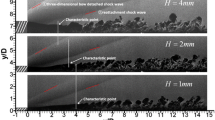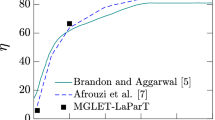Abstract
Large-scale structures in supersonic planar non-reactive shear layer with a base flow region are experimentally investigated. By utilizing the recently developed nanoparticle-based planar laser scattering (NPLS) method, the fine transient streamwise and spanwise flow fields are acquired, and the large-scale structures in the reattachment region, initial turbulent shear region, and developing turbulent shear region are analyzed. The predominant instability is convective for the two separated shear layer, whereas the instability in the base flow zone is still absolute according to the linear instability analysis. From the initial to developing turbulent shear layer region, the predominant instability transited gradually from absolute to convective instability, and the corresponding scales of the large-scale structures turn from about half to whole of the shear layer thickness. The entire streamwise mean flow topology and the streamwise and transverse velocity fluctuations are compared with different pressure ratios and with incompressible blunt trailing-edge shear layer. Linear instability analysis shows further evidence to the instability evolution of the supersonic shear layer with a base flow along the streamwise. It implied that instability induced by unmatched pressure in the wake zone can increase the absolute instability and improve the receptivity to inflow perturbations. The reattachment points are approximated with the intersection points of the reattachment shock pairs, which can be obtained from the transient NPLS images. The distribution of the reattachment points suggests that: the principal axis of the reattachment point distribution is dominated by the high-speed flow, and unmatched pressure increases the perturbation in the wake zone, result in a high absolute instability.
Graphical abstract










Similar content being viewed by others
References
Bourdon CJ and Dutton JC (2001) Visualizations and measurements of axisymmetric base flows altered by surface disturbances. In: 39th AIAA aerospace sciences meeting and exhibit. AIAA 2001-0286
Braud C, Heitz D, Arroyo G, Perret L, Delville J, Bonnet JP (2004) Low-dimensional analysis, using POD, for two mixing layer-wake interactions. Int J Heat Fluid Flow 25:351–363
Chen JH, Cantwell BJ, Mansour NN (1990) The effect of Mach number on the stability of a plane supersonic wake. Phys Fluids A 2(6):984–1004
Clemens NT, Narayanaswamy V (2014) Low-frequency unsteadiness of shock wave/turbulent boundary layer interactions. Annu Rev Fluid Mech 46:469–492
Délery J, Dussauge JP (2009) Some physical aspects of shock wave/boundary layer interactions. Shock Waves 19:453–468
Ferrero P, Kartha A, Subbareddyy KP, Candlerz GV, Dimotakis EP (2013) LES of a high-Reynolds number, chemically reacting mixing layer. Fluid dynamics and co-located conferences. AIAA 2013-3185
Koch W (1985) Local instability characteristics and frequency determination of self-excited wake flows. J Sound Vib 99(1):53–83
Laizet S, Lardeau S, Lamballais E (2010) Direct numerical simulation of a mixing layer downstream a thick splitter plate. Phys Fluids 22:1–15
Reedy TM, Elliott GS, Dutton JC, Lee Y (2012) Passive control of high-speed separated flows using splitter plates. AIAA J 50(7):1586–1595
Scarano F, van Oudheusden BW (2003) Planar velocity measurements of a two-dimensional compressible wake. Exp Fluids 34:430–441
Smith MK, Dutton JC (1996) Investigation of large-scale structures in supersonic planar base flows. AIAA J 34(6):1146–1152
von Terzi DA, Sandberg RD, Fasel HF (2009) Identification of large coherent structures in supersonic axisymmetric wakes. Comput Fluids 38:1638–1650
Wallace D, Redekopp LG (1992) Linear instability characteristics of wake-shear layers. Phys Fluids A 4(1):189–191
Zhang H, Wu J, Chen J, Liu W (2014) Characteristics of large-scale structures in supersonic planar mixing layer with finite thickness. Adv Mech Eng 878679:1–15
Zhao Y, Tian L, Yi S (2009) Supersonic flow imaging via nanoparticles. Sci China Ser Tech 52(12):3640–3648
Zhao Y, Yi S, Tian L, He L, Cheng Z (2010a) Multiresolution analysis of density fluctuation in supersonic mixing layer. Sci China Technol Sci 53(2):584–591
Zhao Y, Yi S, Tian L, He L, Cheng Z (2010b) Density field measurement and approximate reconstruction of supersonic mixing layer. Chin Sci Bull 55(19):2004–2009
Acknowledgements
The financial support of the National Natural Science Foundation of China (No. 11172324) is gratefully acknowledged.
Author information
Authors and Affiliations
Corresponding author
Rights and permissions
About this article
Cite this article
Wu, J., Zhang, H. & Chen, J. Investigation of large-scale structures in supersonic planar non-reactive shear layer with a base flow region. J Vis 21, 613–624 (2018). https://doi.org/10.1007/s12650-018-0475-5
Received:
Revised:
Accepted:
Published:
Issue Date:
DOI: https://doi.org/10.1007/s12650-018-0475-5




